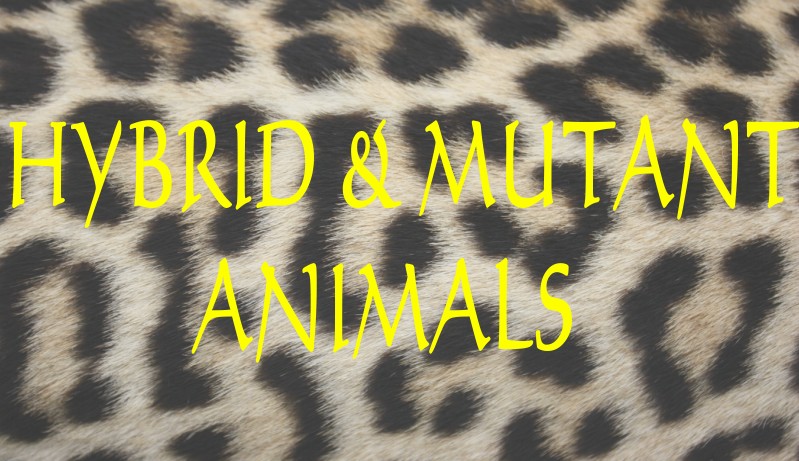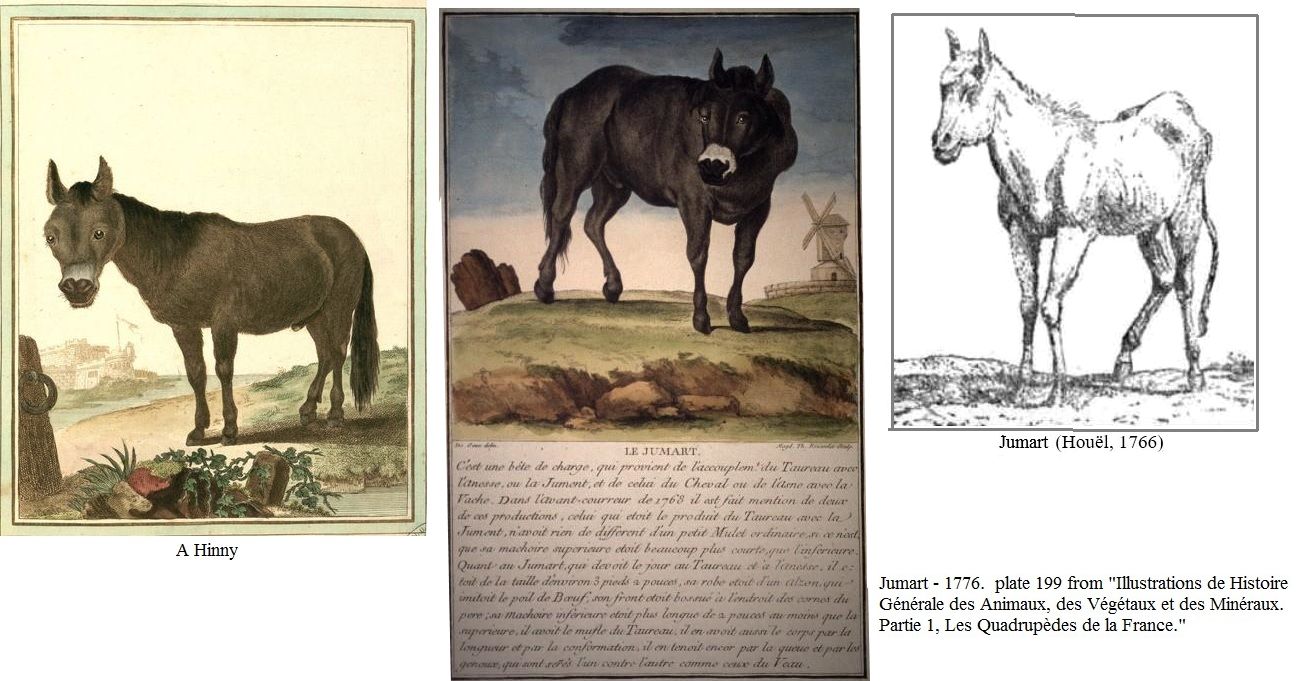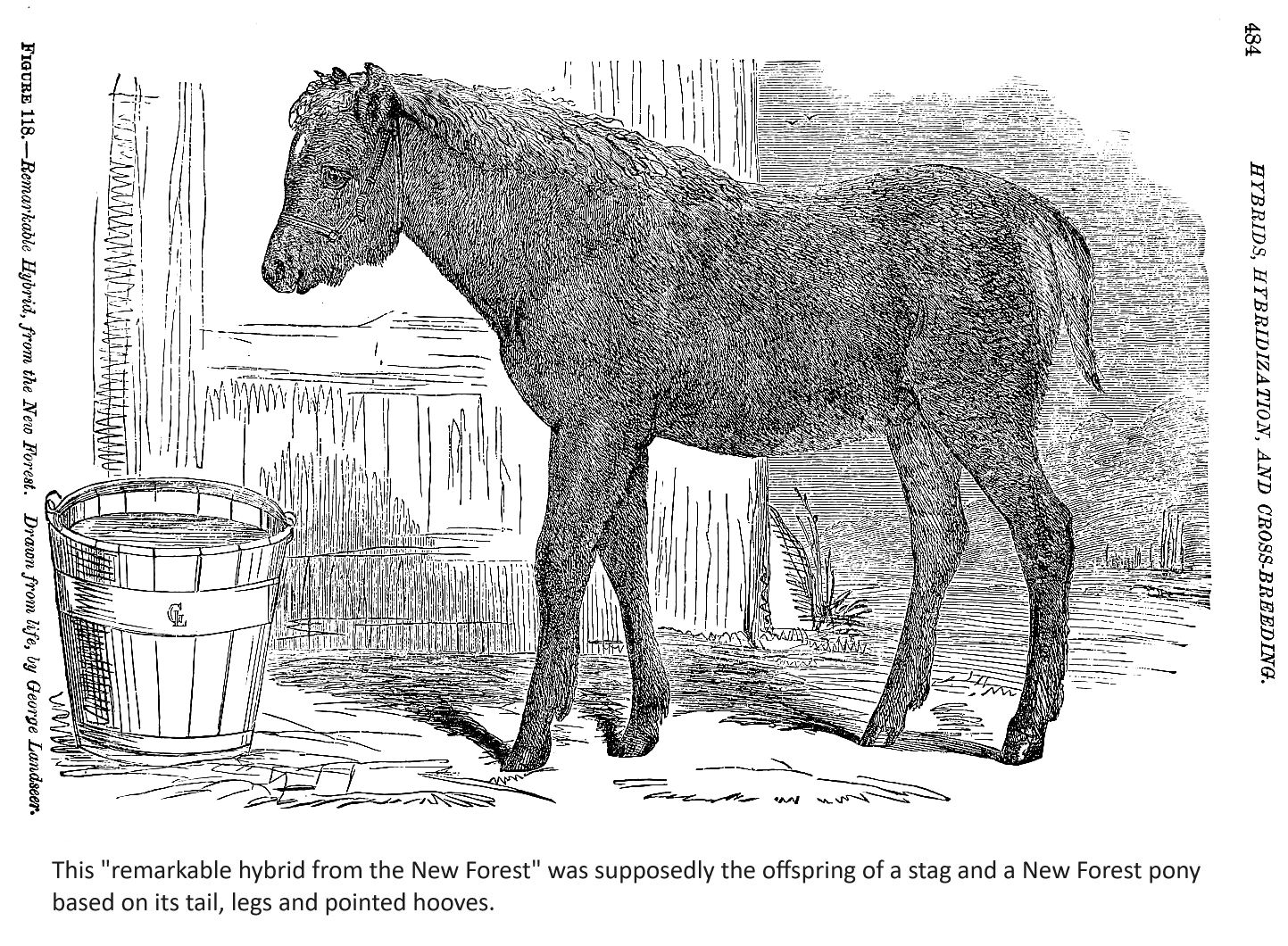

THE ORIGIN OF LIFE AND PROCESS OF REPRODUCTION IN PLANTS AND ANIMALS: WITH THE ANATOMY AND PHYSIOLOGY OF THE HUMAN GENERATIVE SYSTEM, MALE AND FEMALE, AND THE CAUSES, PREVENTION AND CURE OF THE SPECIAL DISEASES TO WHICH IT IS LIABLE: A PLAIN, PRACTICAL TREATISE, FOR POPULAR USE.
CHAPTER XLV. HYBRIDS, HYBRIDIZATION, AND CROSS-BREEDING.
As a rule, only animals of the same kind breed together, and their progeny is of the same kind. But sometimes animals of different kinds will mate, and their progeny will then be a mixture of the two, or a hybrid, as when the horse and ass breed, together, and produce the hybrid called a mule. It was formerly thought that animals of different species could not breed together, and that when any two did breed it proved them to belong to the same species. This, however, is now conceded to be erroneous, for not only different species, but even different genera will cross, and it is only those of different orders which are incapable of intermixing. At what precise point intermixture between two different animals becomes impossible we do not know, but it is certain that it becomes rarer the more remote they are from each other.
It is possible that hybridization would be more frequent, even among widely separated beings, if it were not for differences of structure, which interfere with copulation and gestation. The male sperm and the female germ, even in those of different orders, might intermix and form a hybrid, if they could be brought together under proper conditions. The generative elements are the same in all kinds of beings, but each kind has a particular mode of congregation and gestation. We see this exemplified both in plants and animals, many kinds of both being crossed by artificial aid which never are naturally. Different kinds of fishes, for instance, are crossed this way. One of our previous articles has explained how the human female may be impregnated artificially, by throwing the semen into the womb with a syringe, and it is quite possible that in this way animals might be crossed who cannot copulate.
In some cases of hybridization, the male and female of both kinds intermix either way, and this is called bilateral, or two-sided crossing. Thus we have a mule either from the male ass and female horse, or from the male horse and female ass. In other cases the male of one kind can cross with the female of the other, but the process cannot be reversed. This is called unilateral or one-sided crossing. Thus the male goat will breed with the female sheep, but the male sheep cannot impregnate the female goat. One-sided hybrids are the most common, and even in the two-sided, one way always produces a more perfect being than the other. The mule, for instance, which has the horse for father, is a larger and more perfect animal than the hinny which has the ass for father. Mules are also more readily and certainly obtained than hinnies.
We have no means of judging beforehand whether any two different animals will cross, for some that seem very near together will not do so, while others, apparently very remote, will. Although it is laid down as an invariable rule that different orders will not intermix, still there are some alleged cases of their having done so. The jumart for instance, was said to result from the union of the horse and cow, either way, and this was believed down to the time of Buffon. Thorough investigation however showed that the so-called jumarts were only hinnies, from the union of a horse with a female ass.

All the different species of equus, the horse, zebra, ass, and quagga, breed together; the dog will breed with either the fox or the wolf; the lion with the tiger; the male sheep with the female deer; and the hare with the rabbit. A mastiff dog has also bred with a lioness. Among birds the swan and the goose; the grouse and the black cock; the pheasant and the common fowl; the canary and the goldfinch will intermix, as also many others. Among reptiles, the toad and the frog will cross. And among fishes many curious intermixtures have been obtained.
Hybrids may be of either sex, but the generative system is usually imperfect, so that they are either totally barren, or procreate only to a limited extent. Even when they do procreate, it is usually with one of the parent stock, and but very rarely with each other. The male hybrid is more usually sterile than the female. The female mule, for instance, sometimes has a foal by a male horse or ass, but never by a male mule. In fact, the semen of the male mule usually contains no animalcules, as before explained, so that it could not impregnate. One very remarkable exception, however, must be named. M. Roux, of Angouleme, France, has successfully crossed the hare with the rabbit, and the hybrid, called a leporide, is found to be both prolific and valuable. These and similar experiments have been thought to prove that there is not, naturally, any such thing as difference of species.
It has been asserted that all hybrids gradually lose their fertility, and thus, if left to themselves, they would die out in a few generations. This is undoubtedly true of most of them, but there are exceptions.
I have been assured by those who have carefully observed, that even the mulatto, the cross between the white and the black of the human species, is not nearly so prolific by itself as it is with either the pure black or white. While lecturing in Washington, I had much conversation with the late Mr. John C. Calhoun on this subject, .and also with Governor Tazewell of Virginia, and many others. The universal testimony was that two mulattoes, when married, scarcely ever had the average number of children, and that their offspring, if they married, had a still smaller number, while theirs again, when married, were almost invariably barren. At the same time, either generation would regain its prolificness by connecting with either black or white. Mr. Calhoun informed me that it was once a law in the West Indies, as he had been told, that all mulattoes of the fourth generation of regular descent were declared free, but that none were ever found. And it is certain that children of mulatto descent are very rarely to be met with. In my visit to the South, by favor of the above-named gentleman, and others, I had an opportunity of examining a large number of cross-breeds, between black and white, of various degrees, and the result fully satisfied me that few of them were sexually perfect. In the male the testicles are generally small, and lack firmness, while in the female the ovaries and womb are also small. The quadroon, and octoroon, are more perfect than the offspring of two mulattoes, because of the pure white parentage.
Some cross-breeds seem to be an improvement, in certain particulars, upon their parents, but as a rule it is the reverse, although it is occasionally advantageous to breed a certain amount of one kind into another. The crossing of different vegetables, fruits, and flowers, has undoubtedly given us many improved and valuable varieties, some of which are capable of continuing their kind by self-fertilization, while others are not. Every plant always prefers the pollen of its own species, and will take that alone, when mixed with other kinds. To effect a cross, therefore, of any flower, its own stamens must be cut away before their pollen is shed, or it will be sure to be taken in preference to that of the plant we wish to cross with. It is the same with animals, the semen of each kind being always preferred to that of any other animal.
Generally, with plants, the hybrid resembles the male parent more than it does the female; and it is most frequently so with animals. Thus the mule is more like the horse, and the hinny is more like the ass. The mulatto by a white father is also whiter than the one by a black father.
In addition to the hybrids already mentioned, I also find a few others, which are deserving of notice.
M. C. F. Rafinesque, professor of botany in the University at Lexington, Ky., states that a cat was left alone, for some months, in a cabin in Kentucky, with no other cats within fifteen to eighteen miles, and yet was found by the owner on his return with five young ones. They were not young cats, however, but apparently hybrids between the cat and an opossum. The body, and fur, were like that of the mother, but the head, paws, and tail were like those of the opossum. These creatures lived some time, and were shown as curiosities, but they never propagated. In all probability the cat, when in heat, not meeting with a male of her own kind, associated with a male opossum. But if this were so it is a very remarkable case of hybridity, for these animals belong to different orders and types.
M. Rafinesque also says that hunters assure him that the raccoon will cross with the red fox, and he has even seen the skin of one of these hybrids, which apparently resembled much that of the raccoon, but was a real mixture of the two. In this case also the parents were of different orders.
The male buffalo, it is well known, will cross with the common cow, and the progeny will breed, but the domestic bull will not so readily cross with the female buffalo. These half-breed buffaloes are now quite common in the West, and are said to be quite valuable.
The Canada goose will cross with the domestic goose, and the progeny will breed; and the same is the case with the common duck and the muscovy duck, though all these are considered to be of different species.
In all probability many rare and unexpected hybrids could be obtained, by artificial means, and some of them might be valuable, as well as interesting.
When the pairing animals, or plants, are nearly related, so that their offspring is not very dissimilar to them, it is commonly called a cross only, and not a hybrid, but the distinction is only conventional.

A few years ago a remarkable hybrid was found in the New Forest, in the South of England, of which we give an illustration. The account given of it states that "this remarkable filly (seven months old) was found a short time since in the New Forest, and is evidently of a mixed breed, between the horse and the deer. Her mother (a pony mare) was observed to associate with some red deer stags in the New Forest for some months, and, at last, this foal was seen by her side. The nose shows a proximity both to the stag and horse; her forward is round, like that of the deer; legs slender and distinctly double; hoofs pointed, and partly double; color brown, lighter under the belly, and tail like a deer. This extraordinary animal is the property of T. G. Attwater, Esq., of Attwater, at the village of Bodenham, three miles from Salisbury. Dr. Fowler, of that city, has inspected the hybrid, and is quite satisfied of the correctness of the preceding statement; and Colonel Buckley (a keeper of the New Forest) has likewise seen the animal, and is of a similar opinion."
This is one of the most remarkable and best-attested instances of hybridization, between animals very remote from each other, that I have ever met with, and proves that with due care, crosses may be effected to a greater extent than is usually supposed possible.
A gentleman who had lived many years in Africa, and traveled much in the interior, assured me that the people all fully believe in crosses between the chimpanzee and native women. They assured him that it was dangerous for a woman to go alone into the forest, if male chimpanzees were there, because they always seized and violated them. He said further that he had seen many children singularly monkeyfied in appearance, which are said to be the result of such forced unions. What was very remarkable, none of these children spoke. Certainly such hybrids would not be nearly so wonderful as many of those we have described, and there is no reason, structural or otherwise, why they should not be produced. The chimpanzee and the lowest, negro are certainly as nearly related, structurally, as the lowest negro and the Caucasian, and they breed together, either way.
Textual content is licensed under the GFDL.
|
BACK TO HYBRID & MUTANT BIG CATS INDEX |